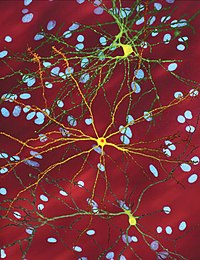
Photo from wikipedia
Ferroptosis is an iron-dependent form of cell death resulting from loss or inhibition of cellular machinery that protects from the accumulation of lipid hydroperoxides. Ferroptosis likely serves a tumor suppressing… Click to show full abstract
Ferroptosis is an iron-dependent form of cell death resulting from loss or inhibition of cellular machinery that protects from the accumulation of lipid hydroperoxides. Ferroptosis likely serves a tumor suppressing function in normal cellular homeostasis, but certain cancers exploit and become highly dependent on specific nodes of the pathway, presumably to survive under conditions of increased oxidative stress and elevated labile ferrous iron levels. Here we introduce Ferroptosis Inducing Peroxide for Chemoproteomics-1 (FIPC-1), a reactivity-based probe that couples Fenton-type reaction with ferrous iron to subsequent protein labeling via concomitant carbon-centered radical generation. We show that FIPC-1 induces ferroptosis in susceptible cell types and labels cellular proteins in an iron-dependent fashion. Use of FIPC-1 in a quantitative chemoproteomics workflow reproducibly enriched protein targets in the thioredoxin, oxidoreductase, and protein disulfide isomerase (PDI) families, among others. In further interrogating the saturable targets of FIPC-1, we identified the PDI family member P4HB and the functionally uncharacterized protein NT5DC2, a member of the haloacid dehalogenase (HAD) superfamily, as previously unrecognized modulators of ferroptosis. Knockdown of these target genes sensitized cells to known ferroptosis inducers, while PACMA31, a previously reported inhibitor of P4HB, directly induced ferroptosis and was highly synergistic with erastin. Overall, this study introduces a new reactivity-based probe of the ferrous iron-dependent interactome and uncovers new targets for the therapeutic modulation of ferroptosis.
Journal Title: Journal of the American Chemical Society
Year Published: 2020
Link to full text (if available)
Share on Social Media: Sign Up to like & get
recommendations!